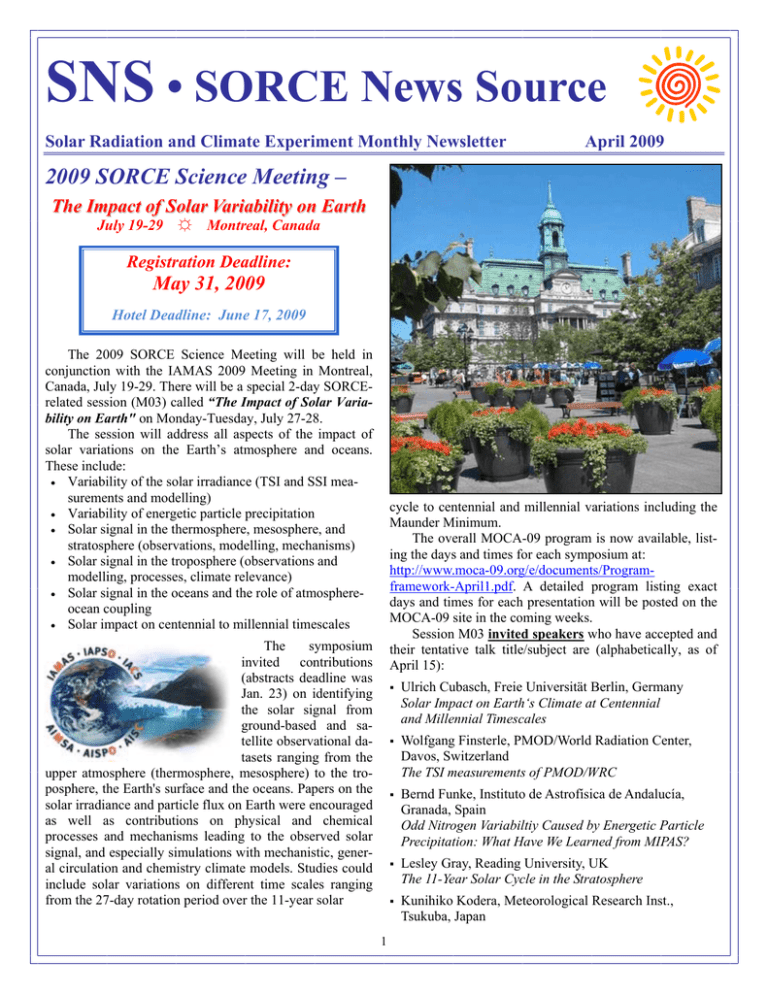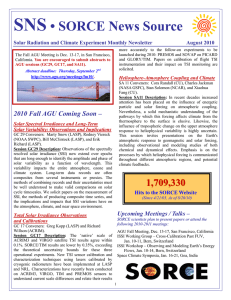SNS • SORCE News Source 2009 SORCE Science Meeting – May 31, 2009
advertisement

SNS • SORCE News Source Solar Radiation and Climate Experiment Monthly Newsletter April 2009 2009 SORCE Science Meeting – The Impact of Solar Variability on Earth July 19-29 ☼ Montreal, Canada Registration Deadline: May 31, 2009 Hotel Deadline: June 17, 2009 The 2009 SORCE Science Meeting will be held in conjunction with the IAMAS 2009 Meeting in Montreal, Canada, July 19-29. There will be a special 2-day SORCErelated session (M03) called “The Impact of Solar Variability on Earth" on Monday-Tuesday, July 27-28. The session will address all aspects of the impact of solar variations on the Earth’s atmosphere and oceans. These include: • Variability of the solar irradiance (TSI and SSI measurements and modelling) • Variability of energetic particle precipitation • Solar signal in the thermosphere, mesosphere, and stratosphere (observations, modelling, mechanisms) • Solar signal in the troposphere (observations and modelling, processes, climate relevance) • Solar signal in the oceans and the role of atmosphereocean coupling • Solar impact on centennial to millennial timescales cycle to centennial and millennial variations including the Maunder Minimum. The overall MOCA-09 program is now available, listing the days and times for each symposium at: http://www.moca-09.org/e/documents/Programframework-April1.pdf. A detailed program listing exact days and times for each presentation will be posted on the MOCA-09 site in the coming weeks. Session M03 invited speakers who have accepted and their tentative talk title/subject are (alphabetically, as of April 15): The symposium invited contributions (abstracts deadline was Jan. 23) on identifying the solar signal from ground-based and satellite observational datasets ranging from the upper atmosphere (thermosphere, mesosphere) to the troposphere, the Earth's surface and the oceans. Papers on the solar irradiance and particle flux on Earth were encouraged as well as contributions on physical and chemical processes and mechanisms leading to the observed solar signal, and especially simulations with mechanistic, general circulation and chemistry climate models. Studies could include solar variations on different time scales ranging from the 27-day rotation period over the 11-year solar 1 Ulrich Cubasch, Freie Universität Berlin, Germany Solar Impact on Earth‘s Climate at Centennial and Millennial Timescales Wolfgang Finsterle, PMOD/World Radiation Center, Davos, Switzerland The TSI measurements of PMOD/WRC Bernd Funke, Instituto de Astrofísica de Andalucía, Granada, Spain Odd Nitrogen Variabiltiy Caused by Energetic Particle Precipitation: What Have We Learned from MIPAS? Lesley Gray, Reading University, UK The 11-Year Solar Cycle in the Stratosphere Kunihiko Kodera, Meteorological Research Inst., Tsukuba, Japan Session conveners are Ulrike Langematz (Freie Universität Berlin, Germany), Victor Fomichev (York University, Toronto, Ontario, Canada), Joanna Haigh (Imperial College, London, UK), Lon Hood (Univ. of Arizona, Tucson), Alexei Krivolustsky, Werner Schmutz (PMOD/World Radiation Center, Davos, Switzerland), and Tom Woods (LASP, Univ. of Colorado, Boulder). Following Monday’s M03 session, July 27, there will be a group science dinner at a restaurant near the Convention Center for anyone interested. Attendees will be on their own for the dinner expense. More details coming, and pre-registration will most likely not be required. For general IAMAS 2009 Meeting information and science program, visit: http://iamas-iapso-iacs-2009-montreal.ca/index.asp. The SORCE-related session is IAMAS session M03. Conceptual Model for the Solar Influence from the Stratosphere Greg Kopp, LASP, Univ. of Colorado, Boulder Total Solar Irradiance Measurements from the Total Irradiance Monitor Katja Matthes, Freie Universität Berlin, Germany Solar-QBO Interactions in the Middle Atmosphere: An Overview Raimund Muscheler, Lund University, Sweden Reconstructing Solar Variability with Cosmogenic Radionuclides and the Sun-Climate Link on Centennial to Millennial Time Scales David Rind, NASA GISS, New York, NY The Role of SSTs for the Decadal Atmospheric Solar Signal in Model Studies Hauke Schmidt, Max Planck Inst. for Meteorology, Hamburg, Germany Solar Signal in Temperature and Chemistry of the Mesosphere and Lower Thermosphere Kirill Semeniuk, York Univ., Toronto, Canada Impact of Ionizing Particle Precipitation on the Middle Atmosphere Gerard Thuillier, Service d’Aéronomie du CNRS, France The Solar Spectrum: Methods of Measurements Calibration, and Recent Results Yvonne Unruh, Imperial College, London, UK Solar Spectral Irradiance Modeling: Rotational to Solar-cycle Timescales Warren White, Univ. of California at San Diego, Scripps Inst. of Oceanography, La Jolla Non-Linear Alignment of El Niño to the 11-Year Solar Cycle in Observations and Models We hope that you will join us! SORCE Team Attends Freiburg ESA EUV-IR Validation Workshop – The ESA (European Space Agency) Solar EUV-IR Validation Workshop was April 15-17, in Freiburg, Germany at the Fraunhofer Institute for Physical Measurement (IPM) Techniques. This gathering of almost 35 international solar scientists is an important part of all solar irradiance programs because it provides validation of our measurements made in 2008 from the TIMED and SORCE satellites and from a rocket flight with the prototype SDO EVE instrument. Attending on behalf of SORCE was PI Tom Woods (XPS), Jerry Harder and Margit Haberreiter (SIM and SRPM), Marty Snow and Bill McClintock (SOLSTICE), Session M03 contributed talks/posters (alphabetically, as of April 15) are: Sergei Avakyan Will Ball Chiara Cagnazzo Robert Cahalan Sebastian Dikty Suvarna Fadnavis Vitali Fioletov Claus Fröhlich Jerry Harder Libor Hejkrlik Lon Hood Radan Huth Alexei Krivolutsky Anne Kubin Jae Lee Doug Lindholm Hua Lu Sabri Mekaoui Joseph Pagaran Jing Pan Peter Pilewskie Erik Richard Susanne Rohs Indrani Roy Semjon Schimanke Werner Schmutz Marty Snow Friedhelm Steinhilber Oran R. White Tom Woods Dong Wu Tiangui Xiao Fangqun Yu 2 NASA ESD Sr. Review Panel Meeting May 13 – and Greg Kopp (TIM). The workshop attendees discussed solar science results in the EUV, UV, Visible, NIR, and TSI. Another important focus of this workshop was to compare measurements from the three SOLAR instruments on the International Space Station with the LASP instrument measurements. Collaborating with the international community to cross-validate solar irradiance measurements is imperative for maintaining long-term records. The workshop topics included: • Calibration discussion on space instrumentation and validation • WHI Solar Irradiance Spectra (SIRS) from the April 2008 campaign and development of an irradiance data base for solar minimum conditions • Development of an irradiance data base for solar active minimum conditions • TSI measurements and analysis • Modeling of the solar spectral irradiance • Irradiance indices for solar and solar-terrestrial relation modeling and their applications • Solar variability in the transition region as a function of temperature to be derived by intercomparisons of data Three members of the SORCE Team will stand before the NASA Earth Science Division (ESD) Sr. Review Panel on May 13 to discuss SORCE’s Extended Mission. The NASA ESD of the Science Mission Directorate (SMD) is supporting 13 Earth observing missions that are, or soon will be, operating beyond their prime mission lifetimes. Since extended operations and associated data production activities require a significant fraction of the ESD annual budget, NASA periodically evaluates the allocation of funds with the aim of maximizing the missions’ contributions. The SORCE team submitted the SORCE Extended Mission Proposal for 2010-2013 in March, and the presentation to the Sr. Review Panel is a follow-up opportunity for them to ask questions so they really understand the SORCE extended mission plans and goals. All NASA Earth Science Missions were required to submit a proposal that included scientific productivity, contribution to national objectives, technical status, and budget efficiency. This evaluation process is known as the “Senior Review”. SORCE Principal Investigator Tom Woods, will attend this panel review, along with Tom Sparn, LASP SORCE Project Manager; Ed Chang, NASA SORCE Project Manager; and Robert Cahalan, NASA SORCE Project Scientist. Following the workshop, Tom Woods, Jerry Harder, Greg Kopp, and Margit Haberreiter continued on to Vienna, Austria, to attend the European Geosciences Union (EGU) General Assembly, April 19-24. This meeting provided an opportunity for the SORCE team to communicate their research results to a broader international community. It was also a chance to promote collaborations with the other solar, climate, and space weather communities. Of particular interest during the EGU Meeting were several compelling talks about observations showing that the solar cycle 23 minimum is lower than the cycle 22 minimum. We hope to follow-up with additional discussions on this topic at the 2009 SORCE gathering in Montreal in July (Session M03 at IAMAS, see page 1). It is expected that this topic will be of even more interest in the future when there is more data to analyze – an excellent topic for the 2010 SORCE Science Team Meeting. Upcoming Meetings / Talks – SORCE scientists plan to present papers or attend the following 2009 meetings: ESA Solar EUV-IR Validation Workshop, April 15-17, Freiberg, Germany EGU General Assembly, April 19-24, Vienna, Austria Space Weather Workshop, April 28-May 1, Boulder, Colorado ISSI Working Group – Cross-calibration of past FUV Experiments, May 25-28, Bern Switzerland AAS/Solar Physics Division Meeting, June 14-18, Boulder, Colorado IAMAS/APSO – SORCE Meeting, July 19-29, Montreal, Canada SOHO-23: Understanding a Peculiar Solar Minimum, Sept. 21-25, Northeast Harbor, Maine 993,447 Hits to the SORCE Website (Since 4/21/03, As of 4/24/09) To submit information to this newsletter, please contact: vanessa.george@lasp.colorado.edu. 3




